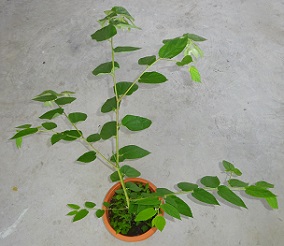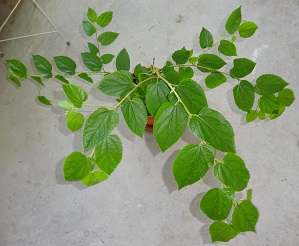| Home | Nature Weekly Index |
5 February 2017 | Wild Cherry Tree | Muntingia calabura |

 After cutting down the 4 small potted
wild cherry trees (Muntingia calabura) along my corridor area
in March 2015, only one of them manged to re-grow from the
remaining leafless trunk. Two pots were then planted with
Sweet Leaf Bush (Sauropus androgynus) with the undergrowth herb
being King of Bitters (Andrographis paniculata). As for the
4th pot, it housed an Air Potato Vine (Dioscorea bulbifera)
but it was gone since September 2016. I transplanted my old
Pandan (Pandanus amaryllifolius) over but it did not work out.
The pot was left vacant after the Pandan died 2 weeks later.
After cutting down the 4 small potted
wild cherry trees (Muntingia calabura) along my corridor area
in March 2015, only one of them manged to re-grow from the
remaining leafless trunk. Two pots were then planted with
Sweet Leaf Bush (Sauropus androgynus) with the undergrowth herb
being King of Bitters (Andrographis paniculata). As for the
4th pot, it housed an Air Potato Vine (Dioscorea bulbifera)
but it was gone since September 2016. I transplanted my old
Pandan (Pandanus amaryllifolius) over but it did not work out.
The pot was left vacant after the Pandan died 2 weeks later.
.jpg) In October 2016, a seedling of wild cherry tree was found in one of the smaller pots.
In October 2016, a seedling of wild cherry tree was found in one of the smaller pots.
.jpg) In fact, all the previous wild cherry trees were from seedlings found in my pots. As I had not decided what to do with the
latest seeding, I had left it with the rest of the plants in that pot. Since it had started later than the other plants in
the pot, its growth potential was suppressed due to competition from others in the same pot. As soon as I moved it into a
newly prepared pot in December, its growth was really fast. By last week, its young branches had spread across to other
pots on the left and right. It was ready to be moved to the large pot along the corridor, which took place last weekend.
In fact, all the previous wild cherry trees were from seedlings found in my pots. As I had not decided what to do with the
latest seeding, I had left it with the rest of the plants in that pot. Since it had started later than the other plants in
the pot, its growth potential was suppressed due to competition from others in the same pot. As soon as I moved it into a
newly prepared pot in December, its growth was really fast. By last week, its young branches had spread across to other
pots on the left and right. It was ready to be moved to the large pot along the corridor, which took place last weekend.
I like to grow wild cherry tree for a few reasons; (1) it is a fast-growing, resilient and easy-to-grow tree, (2) its small cherry-like fruits are fragrant and edible, and (3) its presence reminded me of my childhood days. This tree attracts birds that mainly came for its fruits. In some regions, it is known as Strawberry Tree because the flower looked like that from strawberry. More local information on this tree is available at the taxo4254 website. This naturalised cherry tree should not be confused with the imported cherry (Prunus avium) sold seasonally in the supermarkets here.
While looking up for more information on this tree, I came across a 2014 publication from Malaysia titled “Muntingia calabura: A review of its traditional uses, chemical properties, and pharmacological observations” in the journal Pharmaceutical Biology. What really surprised me was the used of one of my plant photo without citing the source and not seeking my permission to use it. Needless to say, I wrote to the author to ask for an explanation.
Some folks, including the above mentioned article, classified this tree under the family Elaeocarpaceae. This classification might be true before 1998. An article published in 1998 appeared to assign the family to Muntingiaceae.